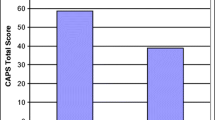Abstract
A review of literature on outpatient treatment of emotionally disturbed adoptees is presented. Key issues in adoption therapy are discussed. A model featuring long-term support for adoptive children and their families is described with a menu of accompanying clinical strategies. Applications in mental health settings and directions for research are reviewed.
Similar content being viewed by others
References
Anderson, J. (1986). Holding therapy. A way of helping unattached children. In P. V. Grade (Ed.),Adoption resources for mental health professoonals (pp. 62–69). Mercer, PA: Mental Health Adoption Project.
Aust, P.H. (1981). Using the life story book in treatment of children in plaement.Child Welfare, 60, 534–560.
Backhaus, K. (1984). Life books: Tool for working with children in placement.Social Work, 29, 551–554.
Berman, L. C., & Bufferd, R. K. (1986) Family treatment to address loss in adioptive families.Social Casework, 67, 3–11.
Berry, M. & Barth, R. (1989). Behavior problems of children adopted when older.Children and Youth Services Review, 11, 221–228.
Bowlby, J. (1988).Ad secure base: Clinical applications of attachment theory. London: Tavistock.
Bowlby, J. (1980)Attachment and Loss Volume 3. Loss. New-York: Basic.
Brodzinsky, D. M., Schechter, D. E., Braff, A. M., & Singer, L. M. (1984). Psychological and academic adjustment in adopted childern.Journal of Consulting and Clinical Psychology, 52 (4), 582–590.
Brodzinsky, D. M., Schechter, M.D., & Hening, R. M. (1992).Being adopted: The lifelong search for self. Garden City, NJ: Doubleday.
Brodzinsky, D. M., Singer, L. M., & Braff, A. M. (1984). Children's understanding of adoption.Child Development, 55, 869–878.
Cline, F. W. (1992).Hope ff High Risk and Rage Filled Children. Reactive Attachment disorder: theory and Intrusuive Therapy. Evergreen, CO: Author.
Feder, L. (1974). Adoption trauma: Oedipus myth/clinical reality.International Journal of psychoanalysis, 55, 491–493.
Groze, V., Young, J., & Corcran-Rumppe, K. (1991).Post adoption resources for training. networking, and evaluation sevices (PARTNERS): Working with special needs adoptive families in tress. Washington: DC: Department of Health and Human Services.
Groze, V. & Rosenthal, J. A. (1993). Attachment theory and the adoption of children with special needs.Social Work Research & Abstracts, 29, 5–12.
Hartman, A. (1984).Working with adoptive families beyond placement. New York: Child Welfare League of America.
Koller, T.J. (1981).Older child adoption: A new developmental intervention program. Presented at the Annual Meeting of the American Psychological Association. Los Angeles, CA.
Partridge, S., Hornby, H., & McDonald, T. (1986).Legacies of loss: visions of gain, an inside look at adoption disruption. Portland, ME: University of Southern Main, Human Services Development Institute.
Pinderhughees, E. & Rosenberg, K. (1990). Family bonding with high risk placements: a therapy model that promotes the process of becoming a family. InFormed Families: Adoption of Children with Handicaps, pp. 209–230, Haworth Press.
Prew, C., Suter, S., & Carrington, J. (1990).Post-adoption Family Terapy: A practice manual. Chidren's Services Division, Department of Human Resources, State of Oregon.
Rogers, K. Scott, S., and Skinner, J. F. (1992).The life process of adoption in families: Perspectives in treatment. Chidren's Bureau, U.S. Department of Health and Human Serices.
Singer, L. M., Brodzinsky, D. M., Ramsay, D., Stein, M. & Waters, E. (1985). Mother-infant attachment in adoptive families.Child Development, 56, 1543–1551.
Welsh, G. (1988).Holding Time. New York: Simon and Shuster.
Wierzbicki, M. (1993). Psychological adjustment of adoptees: A metaanalysis.Journal of Clinical Child Psychology. 22 (4), 447–454.
Author information
Authors and Affiliations
Rights and permissions
About this article
Cite this article
Hoyle, S.G. Long-term treatment of emotionally disturberd adoptees and their families. Clin Soc Work J 23, 429–440 (1995). https://doi.org/10.1007/BF02191631
Issue Date:
DOI: https://doi.org/10.1007/BF02191631




